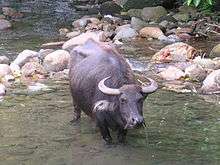carabao
English

A carabao
Etymology
Borrowed from Spanish carabao, from Waray-Waray karabaw.
Pronunciation
- IPA(key): /kæɹəˈbeɪəʊ/
Noun
carabao (plural carabaos)
- A domesticated subspecies of water-buffalo, Bubalus bubalis carabanesis.
- 1999, Neal Stephenson, Cryptonomicon:
- The weaker carabaos are slaughtered for meat, the stronger ones put to work on Golgotha, and the drivers are assimilated into the workforce.
- 2001, Greg Nickles, Philippines: The Culture, page 30,
- Filipinos tell several stories about the carabao. The Tagalog, who live mainly on Luzon, tell the following story about how the carabao, one of the largest animals in the country, is tricked by one of the smallest animals, a hummingbird.
- 2005, Cindy Fazzi, How to Draw the Philippines's Sights and Symbols, page 24,
- The Malay people who arrived in the Philippines between 1500 B.C. and 500 B.C. introduced the carabao as a work animal. Today the carabao, also known as the water buffalo, is a very important animal in the Philippines. Carabaos are popular farm animals.
-
Translations
Bubalus bubalis carabanesis
Spanish
Etymology
From Waray-Waray karabaw; from Proto-Philippine, from Proto-Malayo-Polynesian, ultimately from Austroasiatic.[1]
Pronunciation
- IPA(key): /kaɾaˈbao/, [kaɾaˈβao]
References
- Mahdi, Waruno. (2009), “Some obscure Austroasiatic borrowings in Indonesian and Old Malay”, presented at 11th International Conference on Austronesian Linguistics, Aussois, France, 22 – 25 June 2009
Further reading
- “carabao” in Diccionario de la lengua española, Vigésima tercera edición, Real Academia Española, 2014.
This article is issued from
Wiktionary.
The text is licensed under Creative
Commons - Attribution - Sharealike.
Additional terms may apply for the media files.